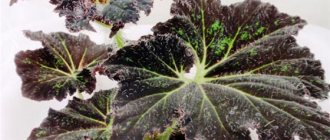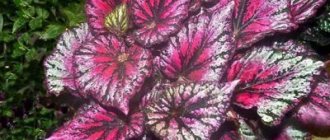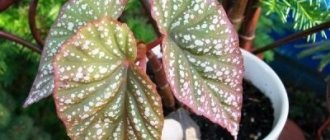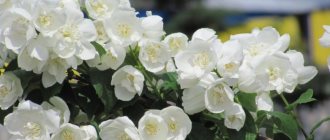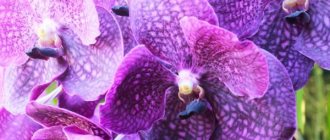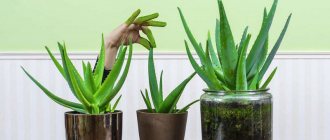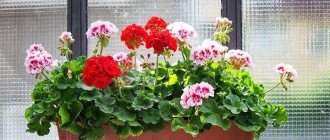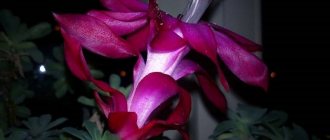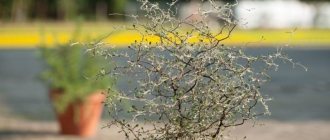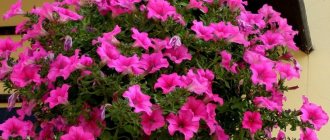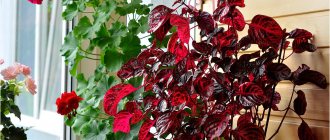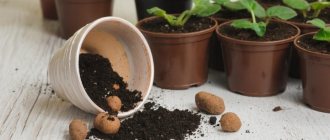Snail
This is a unique variety of begonia. With this interesting plant, you can create a tropical corner right in your apartment.
The flower is a compact bush up to 30 cm high. Its large round leaves have a two-color color. The leaf blade is greenish-brown in color, in the central part there is a wide silvery pattern in the form of a curl or spiral, reminiscent of a snail shell. The surface is matte, covered with short burgundy hairs. The base of the leaf is also twisted into a spiral.
Begonia propagation
Begonia is easily propagated by seeds and several vegetative methods. These are fairly simple methods that even a novice gardener can handle.
Attention! To grow new begonias, it is better to use a separate substrate consisting of sand and begonia soil (peat) in proportions of 1:1 or 3:1.
The number of methods for propagating begonias is determined by the difference between species. Propagation by seeds is an exception and is usually used by breeders.
Cuttings from stems
A universal and simple method suitable for almost all types of begonias. It is often used to rejuvenate the flower. For cuttings, take a piece of stem 10-12 cm long from the upper or middle part of the stem of the mother plant. All leaves except 2-3 at the top are removed. Then you can use two options for the formation of roots:
- Immerse the section in settled warm water and put the container in a bright place for 1.5-2 months. Planting the cuttings in a pot in a permanent place occurs after the roots have formed.
- Treat the lower cut with crushed coal and immediately plant it in a mixture of soil for begonias and coarse sand, deepening it by 1-2 cm. The container on top must be covered with film or a transparent jar and placed in a warm and bright place. The cuttings need to be regularly ventilated and the top layer of soil moistened with a spray bottle: excessive watering will lead to decay. When the sprout produces young shoots, it is transplanted into a pot in a permanent place.
Begonia cuttings
Reference! For faster root formation, you can use special root formation stimulants. They are added to water or treated with the lower cut.
Leaf cuttings
It is better to propagate plants with dense leaf plates in this way, and if desired, grow several new flowers at once. There are three methods for this method. The first is used for flowers with small leaves, since small roots are not capable of feeding a large leaf. For large plates, two other methods are used.
Begonia propagation by leaf
- The plate is cut off at the base and placed in water with the addition of activated carbon. When roots form, the cuttings are planted in a permanent pot. When the sprouts are strong enough, the leaf will dry out.
Reference! If the leaf begins to rot in the water, then it is cut off to the healthy part and the water is changed.
- The leaf is divided so that each segment has part of the central vein. Next, the cuttings are either laid on top of the substrate, lightly sprinkling the edges, or vertically stuck into it, deepened by 1 cm. The container should also be covered with film or glass and placed in a bright and warm place. The mini-greenhouse is not opened until the sprouts appear. After 1-2 months, with the appearance of sprouts, the plant begins to ventilate. As soon as young begonias get stronger, they can be planted in pots with regular soil.
- Cuts are made on the central veins of the leaf from the reverse side and the straightened plate is laid on a damp substrate, fixing it with sand or stones (see video). Cover the container with film or glass and put it in a warm and bright place. After 1-2 months, young shoots grow in the places of the cuts. As soon as they get stronger, they are transplanted into a permanent pot.
Important! With the last two methods, it is necessary to constantly keep the substrate moist. To avoid overwatering, water the cuttings through a tray.
Dividing the root system
This method is more suitable for rejuvenating an old plant. The procedure is carried out in the spring during flower transplantation. Due to the characteristics of begonias, it is divided into two methods:
Rhizome division
This method is often used to renew root begonias. The plant is released from the container and the roots are cleaned from the soil with your hands. Next, the rhizome is divided into parts so that each has at least one bud or shoot. The cut areas must be immediately powdered with crushed coal, and the cutting can be planted in a new pot.
Tuber division
This procedure is carried out in early spring, after a period of dormancy, in order to propagate tuberous bushes. The tuber is taken out of the ground and cut with a sharp knife. All parts of the cuts are treated with a weak solution of potassium permanganate or crushed charcoal. Parts of the tuber are planted in pots in moist soil, each half deepened. The top of the container is covered with a transparent film or glass, which is removed when new leaves appear. Allow the sprouts to grow to 5-7 cm, and completely cover the tuber with soil.
Reference! If buds and shoots appear, it will be easier to divide the tuber: up to 3-5 cm of shoots, the tuber calmly tolerates division. The awakened tuber is divided so that each part has several buds.
Seeds
This is a more labor-intensive and time-consuming method. The main difficulty lies in the size of begonia seeds - they are very small; seeds obtained at home are mixed with sand, flour or starch to reduce the concentration of seeds.
Reference! Store-bought seeds are sold in a shell, which increases the size and provides the seed with nutrients and protection from pests.
Begonia is sown in late February - early March. It is enough to simply spread the seeds over the surface of a damp substrate and cover them with film, glass or a transparent lid. Optimal conditions for germination: temperature 18 ᵒC, air humidity from 50%, bright lighting and periodic ventilation. It is necessary to moisten the surface using a fine spray bottle with water at room temperature. Under these conditions, the seeds will sprout within a week. After the sprouts appear, the container with the seeds can be moved to a warmer place (20-23 ᵒC). When 3-4 leaves appear, each sprout is planted in a separate small pot. With good lighting, they will be able to bloom in the first year.
Alfalfa
A hybrid variety of Coral Begonia with erect reed shoots, reaching a height of two meters. The heart-shaped leaves are quite large, with serrated edges and a pointed tip. The surface is painted in a bright dark green color interspersed with white or silver shades, stripes and clearly defined textured veins. The lower part has a reddish-brown tint.
At the beginning of January, the Lucerne begonia begins its flowering period, which lasts until mid-June. At this time, a large number of peduncles are formed on the plant, on which large pink flowers bloom.
Home care
Each species has its own characteristics in maintenance and care at home. These plants are perennials, although they stop developing after 3 years. Adult bush species become excessively elongated and expose the stems from below, with decorative foliage they lose the brightness of their foliage, and flowering ones stop producing buds. But with proper care at home, indoor begonias can live for more than 10 years.
Reference! After the store, caring for indoor begonia at home is no different from usual, but it is worth paying a little more attention to the flower during the adaptation period.
Lighting and location
Most representatives of the genus are shade-tolerant, but love light. Plants with beautiful flowering prefer partial shade: direct sunlight can burn their leaves. Decorative deciduous varieties, on the contrary, need sunlight: they acquire a more variegated crown color. But they also need to be protected from harsh, aggressive rays.
Bauer's begonia or tiger (begonia bowerae)
Important! The duration of daylight for all species should be at least 12 hours.
The place where to place the container with begonia depends primarily on the species. What attracts more attention: flowers or the crown of a plant. You can place beautiful flowering ones on the windows of the east or west side, or next to it. It is better to place decorative deciduous trees on the window sills of southern windows and shade them at lunchtime.
Reference! Outdoor begonia does not overwinter in open ground, so landscape designers believe that begonia is annual.
Humidity
The flower loves high air humidity, about 60-70%. For home care, a humidity level above 50% will be sufficient. It is better to maintain high humidity using a humidifier or a tray with wet expanded clay. It is not advisable to spray the plant: drops of water can leave unsightly spots on the leaves.
Temperature
Begonia prefers moderate temperatures. In summer it should be kept within 18-23 °C. At higher temperatures, above 26 ᵒC, the plant loses its decorative appearance. The bush does not like sudden changes in temperature and drafts, and can react very sharply to them.
Important! In winter, you need to pay attention to the location of the flower: the crown should not touch cold windows. It is also important to monitor the temperature difference between the above-ground and underground parts of the plant.
In winter, the external temperature should drop below 13 ᵒC; it is better to place the plant in a room with a temperature of about 15 °C. At lower temperatures, the bush may get sick. The critical temperature is 4 ᵒC and below - if a flower is kept in a room with such a temperature, it cannot be saved.
Reference! Tuberous begonias have their own peculiarity: during the rest period, the above-ground part completely dies and is cut off, the remaining tubers are stored in a dark, cool place with a temperature of 7-8 ᵒC.
Rest period
Caring for indoor begonia at home in winter differs from summer. With the exception of tuberous plants, other species have a weak dormant period. Wintering of the flower occurs at 15-16 ᵒC. It is necessary to maintain high air humidity and long daylight hours using special lamps. You should not water begonia the same way as in summer - the soil may dry out faster or slower, so the watering regime should be adjusted. By spring, watering is gradually increased.
Reference! Ever-blooming varieties, if properly maintained and fertilized, require almost no rest period and bloom all year round. But it is also advisable for her to have a rest from January to the end of March, thanks to this she will bloom more abundantly and develop better.
Tuberous plants have a longer dormant period. Already in mid-October, she begins to prepare for rest on her own: the leaves begin to dry out and gradually die off. Gradually reduce watering and completely stop fertilizing the flower. If the plant does not go into a dormant state in the fall, then you need to forcefully prepare it: gradually reduce watering and cut off the stems at the soil surface. The pot with the tuber is covered with a bag or film and put in a dark place with a temperature of 7-9 ᵒC. The tuber is stored until spring, when it is transplanted into fresh soil.
Dormant period for begonia
Important! Until young tuberous begonias form a medium-sized tuber, they are not pruned and put into a dormant state like other species. Usually, after the first full flowering, the root system is fully formed.
Soil and pot
Begonias require nutritious soil with neutral or weak acidity (pH 5.5-6). The plant does not like stagnant moisture, so the soil should be loose and well-permeable to water and air. You can purchase a specialized substrate for begonias, or mix it yourself. The composition of the soil for begonias should include treated leaf soil, peat, humus and coarse sand in a ratio of 2:1:1:1. Instead of humus, you can use high-moor peat.
It is better to take a pot for begonias that is wide and not high: the roots will form correctly and the risk of hypothermia and rotting will be eliminated. When replanting, a new container is needed 3-4 cm larger than the previous one, with good drainage holes.
Important! If you transplant the bush into a pot with a large amount of free soil, then the roots of decorative deciduous begonias may turn sour, and flowering ones will not produce buds until the entire volume of the pot has been used.
For drainage, it is better to use expanded clay or large pebbles. It is poured into a third of the pot.
Transfer
Begonia needs to change the pot when the roots have completely mastered the lump of earth. Young plants up to 3 years old need it every year, and adults – once every 2 years. If the pot is not fully developed, then simply replacing the top layer of soil is enough.
Important! You cannot replant begonias during flowering after purchase. It is better to wait until the buds wither and then replant - if the flowers are left in it, they will wither.
Begonia root system
The procedure is carried out in the spring, at the beginning of the period of active growth. If the plant is healthy and there are no signs of disease, the flower is simply transferred into a new container. Before replanting, water the soil well: this will make it easier to remove the plant from the pot and maintain the shape of the soil. You can replant a store-bought begonia like a regular house one.
Attention! Due to the specific nature of the dormant period, tuberous varieties, with rare exceptions, do not require replanting. They are regrown every spring from tubers.
Pruning and rejuvenation
Crown formation is one of the most important stages of begonia care. If this is not done, the plant will eventually lose its decorative appearance: the stems will stretch out and become bare, the bushes will stop blooming. Formation depends on the type:
- In bush begonias, the height of the plant is controlled, the crown is formed in accordance with the wishes of the grower;
- Rhizome plants usually simply require rejuvenation: after 3 years, their stem becomes excessively elongated and bare;
- Tuberous and ever-flowering plants are constantly pinched, forming a crown;
- In ampelous begonias, at the beginning of the period of active growth, shoots are cut to a third of their length.
Sanitary pruning is carried out constantly: all leaves and stems that begin to dry out, and fading flowers are removed. How to prune begonia at home is located below (photo step by step).
Reference! For decorative deciduous flowers, they do not play a big role in appearance, so it is customary to remove them at the moment of inflorescence formation: when they bloom, they waste nutrients.
Watering
The plant tolerates drought more easily than excess watering, but you should not allow the soil to dry out too much either. Water begonia at home like ordinary indoor flowers: when the top layer of soil dries 1-2 cm. Use filtered or settled water. Tuberous species, due to the peculiarity of the root system, need to be allowed to dry out more of the earth - at least half. If the soil is too dry, you can place the pot in water for a few minutes: the soil itself will absorb as much as it needs, and the excess will drain off.
Attention! After buying a flower in a store, you should let the soil dry out more, this will help avoid overwatering.
Top dressing
The bush needs nutrients for growth and development, so the plant must be constantly fertilized. You can use either a special fertilizer for begonias or a complex mineral fertilizer. Feeding is required once every two weeks after watering. During rest, the plant is not fertilized.
Important! Large-flowered varieties begin to be fed after the buds form.
Fireworks
A hybrid variety with a height of 15 to 30 cm with large, textured leaves that attract attention with an unusual color. The center of the Fireworks Begonia leaf is a rich brownish-black shade that fades to dark green. There is a purple border along the edge of the plate. The outside of the leaf is completely covered with a thin network of black veins, which connect to the border and form a lace pattern.
Silver Star
A herbaceous plant reaching a height of 25-30 cm. The shrub has large, spectacular oval-shaped leaves with a pointed apex. The surface is lumpy due to small papillae located on it. The color is rich olive with light green veins, along which there are silvery areas that occupy most of the surface.
Perle de Paris
The height of the plant does not exceed 30 cm. Begonia is a lush, well-branched, spreading bush with unusually attractive leaves of a silvery hue. The wavy plate is decorated with a pinkish border. There are dark, clearly visible veins on its surface.
Wintering of the Royal Begonia
When planting and breeding royal begonia at home, competent care is required, without disturbing the watering regime, lack of lighting or cold drafts. It is equally important to provide the deciduous ornamental plant with a full winter.
Royal begonia does not have a pronounced dormant period and develops equally well in summer and winter. But from mid-autumn, when daylight hours are shortening, you should stop fertilizing and reconsider the watering regime (receiving the summer portion of moisture and not receiving enough light, the bushes will begin to stretch, thin out, and become deformed). Therefore, from mid-October, the growth of the plant must be slowed down by reducing watering and lowering the temperature to 16 C. Water the begonia after the top layer of soil in the pot has dried 3 cm. Otherwise, the roots will rot.
Features of the winter period:
- decrease in temperature and poor watering, otherwise the root system will begin to rot;
- decrease in temperature and wet leaves, otherwise the begonia will be affected by the fungus;
- heat and dry air can cause leaves to dry out;
- winter transplantation will cause the plant to get sick;
- cuttings cut during this period will most likely rot.
Chocolate Cream
The most beautiful hybrid begonia, distinguished by large leaves and petioles twisted in the form of a spiral. The leaves have an unusually attractive color: the outer surface is bright plum color with pronounced dark brown veins, the middle part is silvery-light green, with a silvery-pink border along the edges. The edge is fringed with small serrations. It appears to glow with a silvery light.
VARIETIES
- Dollar Down is a miniature plant with sharp scarlet leaves and dark brown edges.
- Mini Merry is a begonia with a bright crimson color, green and silver-white border. In the middle of the leaf there is a burgundy-brown star.
- Benitochiba - begonia with long dark green leaves mixed with silver-pink splashes
- Gryphon (Gryphon) - a plant with large, strongly dissected green-pink leaves with carved edges
- Escargot is a begonia with shell-shaped leaves with a wide silver line.
